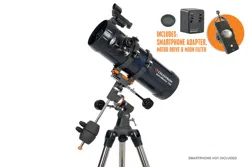Loading ...
Loading ...
Loading ...

18 I ENGLISH
SKY CONDITIONS
Sky conditions can significantly affect the performance of your telescope in three ways.
• Steadiness of the Air- On windy days, images of the Moon and planets will appear to wave or jump around in the
eyepiece; as if you are looking at them through moving water. Nights where winds are calm will offer the best higher
magnification views of the planets and the Moon. The best way to judge the stability of the atmosphere is to look at bright
stars with the naked eye. If they are “twinkling” or rapidly changing colors, the air is unstable and you are better off using
lower powers and looking for deep sky objects. If the stars are sharp and not twinkling, the air is stable and should offer
great high magnification planetary views.
• Transparency- How clear is the air you are looking through? If there is a high amount of humidity in the air, the faint light
from galaxies and nebulae can be scattered and diffused before reaching your telescope, causing a loss of brightness
in your image. Debris in the air from local forest fires or even distant volcanic eruptions can contribute to large loss of
brightness. Sometimes this humidity or debris can help stabilize the air, making for good planetary and lunar images, but
the loss of light would make it difficult to see fainter deep-sky objects.
• Sky Brightness- The amount of ambient light in the atmosphere can also effect deep-sky observing. How dark the sky is
can depend on your local surroundings. In the middle of a city, sky-glow caused by city lights being reflected back to earth
from the sky can overpower the faint light from distant galaxies. Getting away from the bright lights of a major city can
make the difference between seeing a faint deep-sky object and missing it altogether. Planets and the moon are plenty
bright enough on their own so the effect on observing them is minimal.
SELECTING AN OBSERVING SITE
If you are going to be observing deep-sky objects, such as galaxies and nebulae, you should consider traveling to a dark
sky site that is reasonably accessible. It should be away from city lights, a relatively unobstructed view of the horizon, and
upwind of any major source of air pollution. Always choose as high an elevation as possible as this can lower the effects of
atmospheric instability and can ensure that you are above any ground fog. While it can be desirable to take your telescope
to a dark sky site, it is not always necessary. If you plan to view the planets, the Moon or even some of the brighter deep-
sky objects, you can do this from any location, such as your own backyard. Try to setup the scope in a location that is out
of the direct path of streetlights or house lights to help protect your night vision. Try to avoid observing anything that lies
within 5 to 10 degrees over the roof of a building. Rooftops absorb heat during the day and radiate this heat out at night.
This can cause a layer of turbulent air directly over the building that can degrade your image. It is best if you set your
telescope up directly on a dirt or grassy surface. Setting up on any raised platform such as a wooden deck or a hard surface
like concrete or a sidewalk should be avoided as they transmit vibrations easily that can be transferred to the telescope.
Observing through a window is not recommended because the window glass will distort images considerably. And an open
window can be even worse, because warmer indoor air will escape out the window, causing turbulence which also affects
images. Astronomy is an outdoor activity.
CHOOSING THE BEST TIME TO OBSERVE
Try not to view immediately after sunset. After the sun goes down, the Earth is still cooling, causing air turbulence. As the
night goes on, not only will seeing improve, but air pollution and ground lights will often diminish. Some of the best observing
time is often in the early morning hours before dawn. Objects are best observed as they cross the meridian, the imaginary
line that runs from north to south through a point directly over your head. This is the point at which objects reach their highest
points in the sky and your telescope is looking through the least amount of atmosphere possible. Objects that are rising or
setting near the horizon will suffer more atmospheric turbulence since you are looking through a much longer column of air.
It is not always necessary to have cloud-free skies if you are looking at planets or the moon. Often broken cloud conditions
provide excellent seeing.
Loading ...
Loading ...
Loading ...
